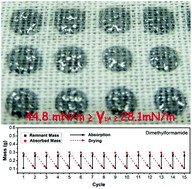Selective surface tension induced patterning on flexible textiles via click chemistry†
Abstract
A solid surface commonly forms two wetting modes by alternating the type of the liquids, i.e. wetting and nonwetting. Here we report that a textile can be programmed to exhibit three wetting modes by simply alternating the surface tension of the liquids, they are in turn, wetting, selective wetting and nonwetting. The hidden patterns are prepared via a combination of wet chemical etching and two-step UV-induced thiol–ene click chemistry to graft low-surface-tension thiols and high-surface-tension thiols, respectively, on the textile surface. The as-prepared flexible textiles possess the nonwetting and wetting properties of the high-surface-tension liquids, such as water and glycerol, and the low-surface-tension liquids, such as decane and ethanol, respectively. Furthermore, the selective wetting behavior can be revealed only if the surface tension of the liquids is within a narrow range of approximately 44.8 mN m−1 to 28.1 mN m−1, such as N,N-dimethylformamide and acetonitrile. In addition, the as-patterned textiles demonstrated high mechanical and chemical stability with long-term and repeated usage, which implies their high potential to act as novel encoded information carrier materials for flexible and textile-based devices.



 Please wait while we load your content...
Please wait while we load your content...